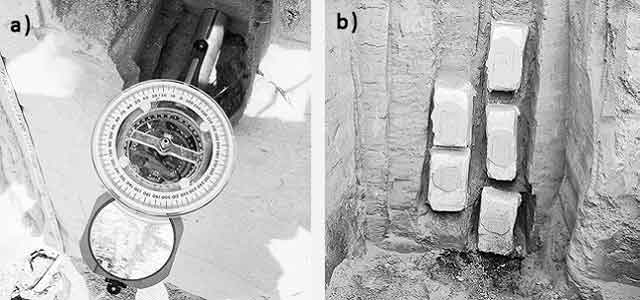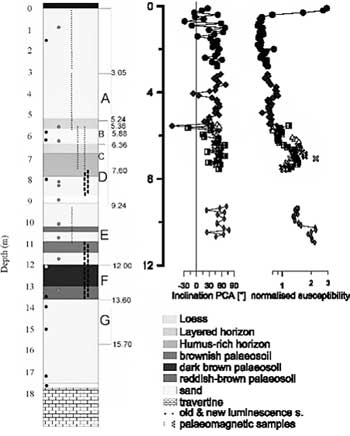LOESSFEST'09 | Aug. 31st – Sept. 3rd, 2009 |Novi Sad-Serbia
A Combined Palaeomagnetic and Environmental Magnetic Investigation of Late Glacial Loess from the Middle Danube Basin (Süttő; Hungary)
Rolf, C.1, Worm, K.2, Hambach, U.2, Schnepp, E.3, Novothny, A.1,4
1Leibniz Institute for Applied Geophysics, Stilleweg 2, 30655 Hannover, Germany
2Department of Geomorphology, University of Bayreuth, Germany
3GeoForschungsZentrum Potsdam, Potsdam, Germany
4Eötvös Loránd University, Institute of Geography and Geology, Department of Physical Geography, Pázmány Péter sétány 1/C. H-1117 Budapest, Hungary
Aeolian dust was deposited worldwide during dry/cold periods of the recent geological past. When more humid conditions prevailed the accumulated dust experienced pedogenesis in contrast to loess forming environments during dry periods. Such alternating environmental conditions led to loess-paleosol sequences (LPSS) covering wide parts of the continents and providing high resolution archives of palaeoclimatic changes during the Pleistocene.
Such a scenario is well known from the Carpathian basin. Loess and loesslike sediments cover more than 30% of the surface of Hungary amongst others at the right bank of the Danube. In order to establish an absolute chronology for late Quaternary deposits from Hungary, different loess-palaeosol sequences have been investigated by luminescence dating performed by the Leibniz Institute for Applied Geophysics (LIAG) in Hannover (Novotny et al. 2009) in collaboration with the Department of Physical Geography of the Eötvös Loránd University of Budapest. In the frame of this collaboration our group took samples at Süttő (right bank of Danube River in the very northern part of Hungary) where a 20 m thick Upper Pleistocene loess-palaeosol sequence crops out, overlying minable travertine. In July 2008, high resolution sampling for palaeomagnetic and environmental magnetic research was carried out.
 Fig. 1. Sampling techniques for palaeomagnetic investigations (taking cylinders (a) or
blocks (cubes) (b)
Fig. 1. Sampling techniques for palaeomagnetic investigations (taking cylinders (a) or
blocks (cubes) (b)
The objectives of our study are: firstly, to establish a palaeomagnetic directional record for additional, independent dating; secondly, to construct a palaeosol- loess stratigraphy based on variations of the magnetic susceptibility (MS) and other rock magnetic proxies with depth in order to reconstruct the palaeoclimatic evolution; thirdly, to build a relative palaeointensity record and to compare this record with the high resolution global palaeointensity stack GLOPIS 75 (Laj et al. 2004). An additional aim was to test a new sampling technique developed by Schnepp et al. (2008) applicable to unconsolidated material.
 Our contribution will present preliminary results of
our magnetic investigations. To get a first overview on
the magnetic properties of the whole sequence at Süttő
we took small cylinders (1 inch in diameter) in adequate
distances (~ 10 cm) and overlapping blocks (~ 10 cm feed
size). Sampling for cylinders was carried out (Fig. 1) using
a more sophisticated technique which yields well oriented
samples suitable not only for alternating field but
also for thermal demagnetisation (Schnepp et al. 2008).
Our contribution will present preliminary results of
our magnetic investigations. To get a first overview on
the magnetic properties of the whole sequence at Süttő
we took small cylinders (1 inch in diameter) in adequate
distances (~ 10 cm) and overlapping blocks (~ 10 cm feed
size). Sampling for cylinders was carried out (Fig. 1) using
a more sophisticated technique which yields well oriented
samples suitable not only for alternating field but
also for thermal demagnetisation (Schnepp et al. 2008).
Fig. 2. Preliminary palaeo- and rock magnetic results (profile
description; inclination (PCA) & susceptibility)
The results of luminescence dating argue for a Last
Interglacial age of the Suettoe pedocomplex (Novothny
et al. 2009, in press). Our magnetic susceptibility record
correlates through the whole sequence quite well with
the loess layers and soil horizons (Fig. 2). Most samples
show a clear palaeomagnetic signal and magnetic cleaning
(thermal or alternating field) yielded stable characteristic
remanences with well defined palaeodirections.
Thus, the profile at Suettoe represents a succession of
palaeodirections characterised mainly by normal polarity
but also with indications of inversely magnetised intervals
in superposition. The large directional scatter in
the uppermost 1.5 m, however, is most probably caused
by imperfect remanence acquisition due to a high sand
content.
Supported by the results of luminescence dating and stratigraphic arguments we assume that the Mono Lake (~32 ka) and Laschamp (~41 ka) geomagnetic episodes (e.g. Channell 2006) have been recorded in the Suettoe profile. Comparing the intervals of assumed geomagnetic excursions with lows in the relative palaeointensity record corroborates our working hypothesis. A second sampling campaign will take place this summer. Additional samples will be taken to hopefully confirm the results obtained so far.
References
- Channell, J. E. T., 2006. Late Brunhes polarity excursions (Mono Lake, Laschamp, Iceland Basin and Pringle Falls) recorded at ODP Site 919 (Irminger Basin). Earth and Planetary Science Letters, 244, (1- 2): 378-393.
- Hambach, U., Rolf, C. & Schnepp, E., 2008. Magnetic dating of Quaternary sediments, volcanites and archaeological material: an overview. E & G Quaternary Science Journal, 57, (1/2): 25-51.
- Laj, C., Kissel, C. & Beer, J., 2004. High resolution paleointensity stack since 75 kyr (GLOPIS-75) calibrated to absolute values. Geophysical Monograph Series, (145): 255-265.
- Novothny, Á., Frechen, M., Horváth, E., Bradák, B., Oches, E. A., McCoy, W. D. & Stevens, T., 2009. Luminescence and amino acid racemization chronology of the loess-paleosol sequence at Süttő, Hungary. Quaternary International, 198, (1-2): 62-76.
- Novothny, Á., Frechen, M., Horváth, E., Krbetschek, M., Tsukamoto, S. (in press): Infrared stimulated luminescence and infrared-radiofluorescence dating of quaternary sediments in Hungary. Quaternary Geochronology.
- Schnepp, E., Worm, K. & Scholger, R., 2008. Improved sampling techniques for baked clay and soft sediments. Geophysical Journal International, 33: 407- 413.



